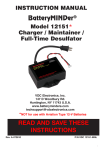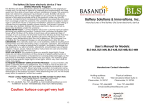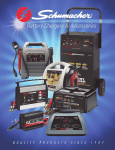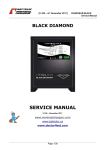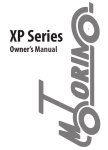Download JASPak Batt-Pak Owner`s Manual
Transcript
JASPak™ Batt-Pak Owner’s Manual Safety First – PLEASE READ ALL PAGES! Ver. 1.1 (6/2013) JASPak Batt-Pak Owner’s Manual Version History: Ver. 0.1 1.0 1.1 Date 3/03/2013 5/14/2013 6/03/2013 Change Initial draft version Status Monitor/Capacity Meter Update Cable Change, Fuse Update 1 Editor J.R.D. J.R.D. J.R.D. JASPak™ Batt-Pak Owner’s Manual Safety First – PLEASE READ ALL PAGES! Ver. 1.1 (6/2013) Contents: Section 1: CAUTIONS AND WARNINGS FOR SAFE OPERATION…………………………………………………Page 3 Section 2: Introduction and Overview of the JASPak™ Batt-Pak………….……………………………………Page 4 Section 3: Standard Features…………………………………………………………………………………………………….Page 5 Section 4: Electrical Overview……………………………………………………………………………………………………Page 5 Section 5: Unpacking, Assembly And Setup……………………………………………………………………………….Page 6 Battery Charging With Included AC Battery Charger……………………………………………………..Page 7 Battery Charging Recommendations…………………………………………………………………………….Page 11 Section 6: Operation………………………………………………………………………………………………………………….Page 12 Section 7: Care And Configuration..…………………………………………………………………………………………..Page 12 _____________________________________________________________________________________ Notes: 2 JASPak™ Batt-Pak Owner’s Manual Safety First – PLEASE READ ALL PAGES! Ver. 1.1 (6/2013) Section 1 - CAUTIONS AND WARNINGS FOR SAFE OPERATION 1. ELECTROCUTION / SHOCK HAZARD: The JASPak™ Batt-Pak is capable of generating very high DC amperage and is not designed to be exposed directly to, or used in rain or other sources of water. Use ONLY in dry environments. 2. CAUTION/PHYSICAL HARM: The JASPak™ Batt-Pak weighs over 100 pounds and can cause physical injury or death if it tips or falls on someone. Always keep the JASPak™ Batt-Pak on its bottom unless it is in transport on the provided wheels. 3. USE: The JASPak™ Batt-Pak BATTERY MUST BE OF EQUAL CHARGE TO THE BATTERY IN THE GENERATOR BEFORE CONNECTING! Do not attempt to connect a fully charged JASPak™ Batt-Pak into a depleted JASPak™ Solar Generator. Doing this will cause intense power flow from the charged battery to the dead battery and may damage or destroy one, or both batteries. 3 JASPak™ Batt-Pak Owner’s Manual Safety First – PLEASE READ ALL PAGES! Ver. 1.1 (6/2013) Section 2 - Introduction and Overview: The JASPak Batt-Pak is an auxiliary battery pack designed to be used in conjunction with your JASPak Solar Generator to increase your running time between charges. The JASPak Batt-Pak uses the exact same battery that is in your generator operating at 12V DC. These batteries are the exact same size, weight and rating. Each JASPak™ Batt-Pak is shipped with its own home charger and just like your generator, we recommend to keep this home charger connected at all times while the JASPak™ Batt-Pak is not in use so that it is always 100% ready for service. The battery charger is micro-processor controlled and designed to calculate the battery voltage and capacity several times a second to assure your battery remains in the best condition possible for years! The most important operational consideration that must be adhered to is the following: Do not attempt to connect a fully charged battery in a JASPak™ Batt-Pak to a depleted battery in a JASPak™ Solar Generator. The 2 batteries MUST BE OF EQUAL CHARGE before connecting them for use together. Large variations in charge will cause an intense flow of power from the charged battery to the depleted battery and you will risk damage to one, or both batteries as they attempt to equalize. Finally, please remember that you have doubled your running time on your generator when the JASPak™ Batt-Pak is attached which means you have also increased your required charging time. Please be sure to account for the additional charging time needed when using both batteries at the same time. 4 JASPak™ Batt-Pak Owner’s Manual Safety First – PLEASE READ ALL PAGES! Ver. 1.1 (6/2013) Section 3 - Standard Features: Mobile Unit: Your JASPak™ Batt-Pak has been built inside a mil-spec shipping container designed for mobility and durability. The pull-up handle and wheels provide you with mobility to move as needed. System Status Monitor: The operating deck contains the system status monitor for providing you with the battery capacity level and current charge status. There is an additional switch located by the capacity meter that will power the LED’s on and off, but the meter itself will continue to monitor the system and charge status and retain the charge status in memory. The switch simply allows power conservation by turning off the LED’s. 12 volt/2 amp Battery Charger/Maintainer/Desulfator: When your JASPak™ Batt-Pak is not in use, we recommend that the included charger remains connected to the JASPak™ Batt-Pak so that it is always 100% ready for service. The battery charger is micro-processor controlled and designed to calculate the battery voltage and capacity several times a second to assure your battery remains in the best condition possible for years! Section 4 - Electrical Overview: This is an electric appliance! The JASPak™ Batt-Pak is capable of producing up to 110 amps of DC current during operation before the primary fuse disrupts the flow of power! There are no user serviceable parts inside of the unit. DO NOT OPEN THE UNIT as this exposes you to significant risk of electric shock or other severe injury. Opening of the JASPak Batt-Pak will void the warranty and no repairs will be covered under warranty once the seal of the operating deck has been broken. Flow of power: From the positive battery post, there is a primary 110 amp fuse and the next connection is made to the generator at the plug. There is NO PRIMARY/MAIN SWITCH to turn on or off. The only connections that exist before the primary 110 amp fuse will be to the 12v/2a battery charger leads and the battery capacity monitor. The AC Battery charging cable does have access to charge the battery at all times and is before the primary fuse. At all times, there are 12 volts of DC power at the end of the AC battery charging whip. There is a rubber cover included on the whip and this cover should be replaced over the charging pins at all times when charging via the AC battery charger is not occurring. Failure to properly cover the charging whip my result in a blown charge circuit fuse and your battery will not properly charge while connected to the AC battery charger. This fuse is user replaceable and built into the AC battery charger whip. It is a 5 amp blade-style fuse. 5 JASPak™ Batt-Pak Owner’s Manual Safety First – PLEASE READ ALL PAGES! Ver. 1.1 (6/2013) Section 5 – Unpacking, Assembly And Setup Unpacking the JASPak™ Batt-Pak unit: 1) Carefully cut off the plastic shipping straps from the carton and remove the JASPak™ Batt-Pak from the carton/pallet. *PLEASE NOTE: The JASPak™ Batt-Pak is VERY HEAVY and this step may require more than 1 person. Please use common sense and know your own ability before attempting to remove on your own. 2) Remove all wrappings from the JASPak™ Batt-Pak and dispose of properly. 3) Fully inspect the outside of the unit for any damage. You will see the heads of various screws and bolts and this is normal. 4) Place the JASPak™ Batt-Pak in a location where it can sit for several hours with the charger connected while reading this manual. With the JASPak™ Batt-Pak firmly on the ground, snap open the 2 latches and open the lid to view the operating deck. 5) Connect the provided 12v/2a battery charger to the charging whip located outside the JASPak™ Batt-Pak. 6) Plug the battery charger into a standard 120 volt outlet. The battery charger will flash all indicator lights to complete a simple self-test and when the test is complete; charging of your battery will begin. Power and Battery Connection light should be GREEN. Indicator will come on showing state of battery charge and present charging stage. 6 JASPak™ Batt-Pak Owner’s Manual Safety First – PLEASE READ ALL PAGES! Ver. 1.1 (6/2013) Battery Charging: The following information is directly from the owner’s manual of BatteryMINDER 2012-AGM by VDC Electronics, Inc.: http://batteryminders.com/details.php?prod=2012-AGM Manual located at : http://batteryminders.com/forms/manuals/2012-AGM.pdf 1) 2) 7 JASPak™ Batt-Pak Owner’s Manual Safety First – PLEASE READ ALL PAGES! 3) 4) 8 Ver. 1.1 (6/2013) JASPak™ Batt-Pak Owner’s Manual Safety First – PLEASE READ ALL PAGES! Ver. 1.1 (6/2013) 5) Charging Stages: a. Soft Start is used if a battery’s voltage is under 10.5V when charging begins. It uses a low constant current to slowly bring up voltage. This prepares a weak or neglected battery for the Constant Current stage. b. Constant Current (sometimes called Bulk) is the main charging stage. The charger puts out a constant current of 2A, its full power. Battery voltage rises until the battery reaches the optimal charging voltage CV* (See Voltage Table). c. Constant Voltage (sometimes called Absorption) is the second charging stage. The charger regulates the current given to the battery to maintain a constant voltage CV* (See Voltage Table). As the battery nears a full charge, the current needed to maintain this voltage decreases. Once the current falls below 0.5A (0.1A for 2012-AGM) the stage is complete. d. Battery Test is administered by reading your battery voltage while resting the battery for 10 minutes. A voltage of under 12.5V indicates a weak battery, under 11.5V indicates a shorted cell. The battery is tested at completion of the Constant Voltage stage, and every 12 hours while in Float e. Float (sometimes called Maintenance) is the charger’s long term stage. The charger can and should be left connected indefinitely. This will keep the battery fully charged ensuring no sulfate can form. The charger maintains float voltage FV* (See Voltage Table) using very little power as it actively monitors the battery and adjusts its output several times a second. 6) Indicator Light Details: a. Power light is GREEN anytime the charger is plugged into AC Power. b. Battery Connection light is GREEN when the unit it is correctly connected to a battery. If the Battery Connection light is RED the polarity is reversed and the positive and negative terminals need to be switched. If the light remains RED after switching the connections, there is a short circuit. c. Battery Weak light is AMBER if the Soft Start mode is used or the battery fails a Battery Test. The indicator will stay on until the battery passes a Battery Test. A neglected battery can take over 2 weeks of desulfation to correct. If after 2 weeks it still reads as a Weak Battery, there is likely internal physical damage. 9 JASPak™ Batt-Pak Owner’s Manual Safety First – PLEASE READ ALL PAGES! Ver. 1.1 (6/2013) d. Load light is AMBER if the charger is in Float and outputting 2A. This indicates a drain on the battery or a large battery that was not charged within the time limits. If possible remove any loads. When this light is on, the battery charge level lights correspond only to battery voltage, not charging stages (see Load Light • Table) e. Bad Cell light flashes RED if the charger has not completed the Constant Current stage in 20 hours and battery voltage is under 11.5V, or if the battery is under 11.5V after a Battery Test. The charger shuts off output to avoid any damage to your battery. Loads or banks of batteries may trigger this mode if they are too large for this charger. Remove any loads and charge batteries individually. f. Testing light flashes BLUE when the unit is performing a Battery Test (see Charging Stages). g. Desulfation light flashes BLUE any time the unit is desulfating. The BatteryMINDer desulfates any time it is outputting current. h. Temperature Compensation light is GREEN if the temperature is over 27°C/80°F, BLUE if the temperature is under 21°C/70°F. BatteryMINDer Model 2012 includes an ambient temperature sensor which allows it to vary the output voltage as necessary to properly charge your battery (-0.025 V/°C). Batteries charged at higher temperatures without compensation will overcharge and may outgas. Batteries charged at lower temperatures without compensation will undercharge allowing sulfation to build, possibly leading to the battery freezing. By using temperature compensation, the BatteryMINDer ensures your battery will never over or under charge, even in extreme conditions. 10 JASPak™ Batt-Pak Owner’s Manual Safety First – PLEASE READ ALL PAGES! Ver. 1.1 (6/2013) Battery Charging Recommendations: 1) We highly recommend you ALWAYS keep the AC charger connected to your JASPak™ Batt-Pak and powered on. This will provide multiple benefits: a. Your battery will ALWAYS be 100% ready for any emergency b. Your battery will be maintained by an advanced micro-processor controlled charging circuit to keep it performing like new for years c. Your battery will not suffer from common sulfation problems normally seen while batteries are charged and the stored and then recharged without use d. The indicators on the charging interface will always be able to tell you the status of your battery e. Your JASPak™ Batt-Pak battery WILL NEVER BE OVERCHARGED – EVER! 2) When the JASPak™ Batt-Pak is connected to your JASPak™ Solar Generator, the AC charger must be disconnected. The solar charging system will charge BOTH batteries while connected and actively charging from the sun. 3) When the AC Charger will not be in use, it is important that you disconnect the charger from the JASPak™ Batt-Pak at the disconnection point in the whip cable. 4) DO NOT have both the solar panel AND AC battery charger connected to the system and operating and providing a charge at the same time. 11 JASPak™ Batt-Pak Owner’s Manual Safety First – PLEASE READ ALL PAGES! Ver. 1.1 (6/2013) Section 6 - Operation: To make sure that you get the most out of your JASPak™ Batt-Pak, be sure you read and completely understand how to operate this system. Failure to completely understand the operation of your JASPak™ Batt-Pak can result in injury or even death. Normal Operation: Normal operation is defined as both the JASPak™ Solar Generator and the JASPak™ Batt-Pak being available and in equal states of charge. 1) Remove the AC battery charger and properly disconnect and cap the whip 2) Switch the battery capacity monitor to ON and verify unit is at 100% 3) Verify the JASPak™ Solar Generator is also at 100% before connecting a fully charged JASPak™ Batt-Pak 4) Connect the JASPak™ Batt-Pak to the plug on the outside of the JASPak™ Solar Generator. This plug will only fit 1 way. 5) With the AC battery charger removed, solar panel connected and system status monitor activated, you are now ready to begin using your JASPak™ Solar Generator with the JASPak™ Batt-Pak attached. Section 7 – Care And Configuration Your JASPak™ Batt-Pak is built with the latest in solar technology from America’s best companies! These components are very advanced in their operation and are designed to bring you a trouble-free, reliable and safe backup power solution. All components that require configurations for operation are already set at the factory and do not need to be changed or adjusted. In fact, by making changes or adjustments, you could affect the overall efficiency and operation of your JASPak™ Solar Generator system – PLEASE DO NOT MAKE ANY CHANGES TO THE COMPONENTS. The 12v AGM Battery: Your JASPak™ Batt-Pak uses a premium VRLA-AGM (Valve Regulated Lead Acid-Absorbed Glass Mat) battery. This battery is a ZERO MAINTENANCE battery and requires no maintenance outside of typical charging. Every JASPak™ Batt-Pak is shipped with a 2a home charging unit and highly recommend that this charging unit is ALWAYS connected to your JASpak™ Batt-Pak unit whenever possible. This home charging unit provides a desulfating feature to constantly monitor and clean the plates inside the battery and will extend your usable life of the battery. No other care is required for your battery. 12
















